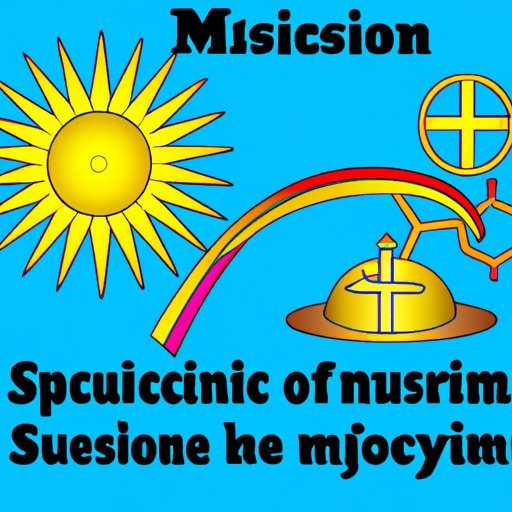Introduction
Science is a vast field with a multitude of disciplines and topics that can be studied and explored. But what about the topics that fall outside of science? What are the boundaries of science and what isn’t considered scientific? This article will explore these questions to gain a better understanding of what isn’t science and how it differs from scientific knowledge.
Exploring the Boundaries of Science: What Isn’t Science?
Before exploring what isn’t science, it is important to first understand what science is. According to the National Academy of Sciences, “Science is the use of evidence to construct testable explanations and predictions of natural phenomena, as well as the knowledge generated through this process.” This definition encompasses the scientific method which involves making observations, formulating hypotheses, conducting experiments, analyzing data, and drawing conclusions.
Topics that do not follow the scientific method are not considered scientific. Examples of non-scientific topics include astrology, homeopathy, fortune-telling, and other fields related to the paranormal and supernatural. These topics are not considered scientific because they cannot be tested or verified using the scientific method. Additionally, many of these topics are based on subjective beliefs rather than objective facts.
It is also important to note that some topics may have a scientific basis but are still not considered scientific. For example, philosophy and ethics are often seen as separate from science, even though they are rooted in scientific principles. This is because these topics rely heavily on personal beliefs, opinions, and values, which cannot be tested using the scientific method.

The Difference Between Science and Pseudoscience
Pseudoscience is another term used to describe topics that are not considered scientific. According to the American Association for the Advancement of Science, pseudoscience is “the practice of making claims, beliefs, or practices that are falsely presented as scientific.” Examples of pseudoscientific topics include astrology, creationism, and certain forms of alternative medicine.
The main difference between science and pseudoscience is that pseudoscience does not follow the scientific method. Pseudoscientific topics often make claims that cannot be tested or verified using scientific evidence. Additionally, pseudoscience often relies on anecdotal evidence or personal testimony rather than empirical data. As such, pseudoscience should not be confused with science.
Religion vs. Science: Separating Faith from Fact
Religious beliefs are another topic that is often seen as separate from science. Religion is defined as “a set of beliefs concerning the cause, nature, and purpose of the universe, especially when considered as the creation of a superhuman agency or agencies, usually involving devotional and ritual observances, and often containing a moral code governing the conduct of human affairs.”
Religious beliefs often conflict with scientific facts. While science provides evidence-based explanations for natural phenomena, religious beliefs are based on faith. As such, it is important to distinguish between faith and fact when considering religious beliefs. While religious beliefs are not considered scientific, they can still be respected and accepted if they do not conflict with scientific facts.
Examining Non-Scientific Beliefs in Today’s Society
In today’s society, there are many non-scientific beliefs that are widely accepted and believed. Examples of such beliefs include conspiracy theories, the power of positive thinking, and the law of attraction. While these topics may have some basis in scientific principles, they are not considered scientific due to their reliance on subjective beliefs and personal testimonies.
People may believe in such topics for a variety of reasons. Some may find comfort in believing in something that cannot be explained by science, while others may be influenced by popular culture and media. Whatever the reason, it is important to understand that these topics are not supported by scientific evidence.

Superstition and Its Role in Society
Superstition is another topic that is often seen as separate from science. Superstition is defined as “a belief or practice resulting from ignorance, fear of the unknown, trust in magic or chance, or a false conception of causation.” Examples of superstitious beliefs include the notion that black cats bring bad luck, knocking on wood for good luck, and avoiding walking under ladders.
People may believe in superstitions for a variety of reasons. Some may find comfort in believing in something that cannot be explained by science, while others may be influenced by popular culture and media. Whatever the reason, it is important to understand that superstitions are not supported by scientific evidence.

Understanding the Limits of Scientific Knowledge
It is also important to understand that there are some topics that are simply beyond the scope of scientific knowledge. These topics include ethical issues, metaphysical questions, and philosophical musings. While science may provide insight into these topics, it is ultimately up to each individual to draw their own conclusions.
For example, science can provide evidence-based answers to questions about the nature of the universe, but it cannot answer questions about morality or the meaning of life. These topics are beyond the scope of scientific knowledge and must be answered on an individual basis.
Analyzing Popular Myths and Misconceptions
Finally, it is important to examine popular myths and misconceptions that are widely accepted in today’s society. Examples of such myths include the notion that vaccines cause autism, that the moon landing was faked, and that the world is flat. While these topics may seem credible at first glance, they are not supported by scientific evidence and should be dismissed as false.
People may believe in such myths and misconceptions for a variety of reasons. Some may find comfort in believing in something that cannot be explained by science, while others may be influenced by popular culture and media. Whatever the reason, it is important to understand that these topics are not supported by scientific evidence.
Conclusion
In conclusion, this article has explored the boundaries of science and understanding what isn’t science. Topics discussed include pseudoscience, religious beliefs, superstitions, and popular myths and misconceptions. It is important to understand that science is limited by its reliance on the scientific method and that some topics are simply beyond the scope of scientific knowledge. It is also important to distinguish between faith and fact when considering religious beliefs and to dismiss popular myths and misconceptions that are not backed by scientific evidence.
(Note: Is this article not meeting your expectations? Do you have knowledge or insights to share? Unlock new opportunities and expand your reach by joining our authors team. Click Registration to join us and share your expertise with our readers.)
